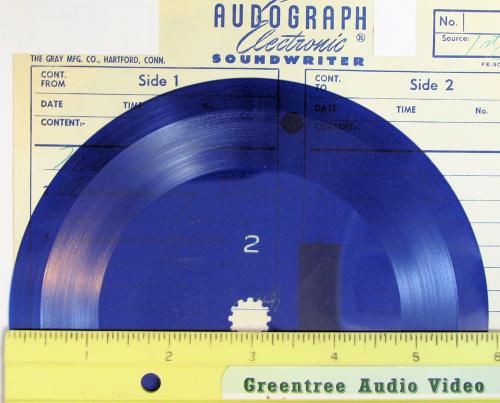
Records

RECORDS 16, 33, 45, 78 rpm transfer to file
Complete pricing below.
Records are flat circular disks with grooves in the surface used to reproduce sound and have a constant rotational speed. Edison (New Jersey) is credited with developing the first sound reproduction ‘phonograph’ in 1877 by using a spiral grooved impression in a tin foil covered cylinder. Bell (Washington D.C., New York) improved the cylinder by covering it with hard wax and called it a ‘graphophone’ in the 1887. Berliner (Philadelphia) patented a flat record disc called a ‘gramophone’ in 1894 and commercialized it using the ‘Berliner Gramophone’ trademark. Improvements to wax master recordings made records worthy of established musicians making opera, instrumental, and jazz recordings accessible to the public. Early records quickly 'wore out' with multiple plays. Berliner formed the Victor Talking Machine Co. in 1901 as a result of lawsuits and developed the popular Victrola record player. In 1929 part of Victor became the Japanese Victor Company (JVC) and the remainder merged with RCA (who was a major competitor in radio) becoming RCA Victor. Record grooves have been made with various materials over the years including wax, phenolic, schellac, aulminum, and acetate. And cores have been made from brittle phenolic, aluminum, cardboard, and (modern) vinyl.

GRAY AUDOGRAPH RECORD
GRAY AUDOGRAPH record transfe to audio file. Complete pricing below.
Gray Audograph records were introduced by the Gray Manufacturing Company of Hartford Connecticut in 1945 for recording audio dictation. Gray Audograph disks are blue flexible grooved disks with a star center hub. They play with a constant speed under the needle that is achieved by rotating the disks with a variable rotational speed of approx. 33 rpm to 15 rpm starting from the center and playing outward towards the edge. The needle is fixed and the record platter rotates and slides with an intricate mechanical design. The spacing between the record grooves is approx. 0.100mm (0.004-inches). Disks can be "resurfaced" to remove the groves and can be reused. Soundwriter machines will record and playback 20, 30, and 60-minute disks. Other names associated with this format are Gray Flexograph, Gray Transcriptions, Electronic Sound Writer, Gray Audograph, and Phonaudograph.
16-inch TRANSCRIPTION Disk
16-inch TRANSCRIPTION disk transfer to file. Complete pricing below.Transcription Disks (Electronic Transcription (ET), “platter”) are grooved audio recordings on 16-inch diameter records developed by Jewett (Western Electric Chicago, New York). They were developed for radio broadcast and were in use from the 1920s through 1960s. Transcription Disks were used to record original radio programming and copies shared between affiliated radio stations for broadcast or purchased by others. Programming included religious, music, drama, and entertainment. The first radio broadcast was a 1906 Christmas concert to commercial sea borne vessels in the Atlantic Ocean and Caribbean Sea. The first commercial radio station was KDKA in Pittsburgh, PA in 1920. Transcription disks play at a speed of 33-1/3rpm for up to 20 minutes per side; some transcription disks play from the center outwards. Sound grooves are cut into a coating of shellac, black cellulose nitrate, or vinyl (poly vinyl chloride) over cores made of aluminum, glass, or vinyl (vinyl used after 1940).

General Prices
Testimonials
Thanks, we received the package [45rpm record and reel to reel] with the mp3 files on flash drive and all is good. Thanks again, I will tell my family and friends about your service...god bless.
Ron Hawaii HI 96771
I'm so happy [that you could play/ transfer these Recordio 78 rpm records to mp3 files on flash drive]. Thank you for doing what you do...preserving family memories...
Richard
Got the [16-inch transcription disk] record today. Great job. If I get another radio commercial record I will contact you. Thanks,
Joe Wisconsin WI 53110
Received the flash drive [with aiff and mp3 file] and [Recordio] reccord back. Great job, it is amazing to hear my uncle back in the 1940s. I will for sure recommend you to anyone that needs your services. Enjoy your day,
Jim New Jersey NJ 08816
Thank you so much, everything downloaded great - thanks again! 78 rpm record
Robert CA California
I am back in PA visiting relatives and have dozzens more Gray Audograph records to send to you. One of the ones you did was 75 years old- incredible! It included my Grandfather talking to my Great Grandmother and to Judge Wade. Thanks again for your help! Mike in Pennsylvania
How it works:
2. Print our SHIPPING LABEL from the tab at the top of the web page.
3. Number your tapes/media, keep a list, and enclose titles and contact info.
4. Seal in plastic bags and pack well, save the Tracking number.
Recommend Postal Priority or Advantage mail most orders. Heavy: UPS.
5. We confirm arrival, email findings after recorded, and bill using PayPal.
Paypal accepts credit cards - you do not need to be a member (we are).
Prepay and checks accepted; make checks payable to "Anthony Schreiber".
6. Order shipped, Downloads after payment. Normal completion is 3 weeks.
7. Most shipments: Postal Priority or Advantage mail $15.00.
